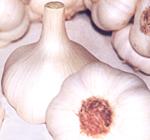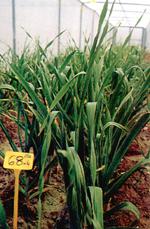| Fruits |
Vegetables
|
|
Note: Composition for 100 g. of fresh product Values in ( min. - max. ) format. | |
| Energy: 80.00-138.92 kcal Fats: 0.12-1.10 g Fibres: 4.10-4.10 g Fat Acids Saturated: 0.10-0.10 gPolyunsat.: 0.30-0.30 g Minerals Calcium: 17.00-38.00 mgZinc: 0.575-1.00 mg Chlorine: 30.00-73.00 mg Phosporus: 86.00-170.00 mg Iron: 0.80-1.90 mg Magnesium: 25.00-25.00 mg Manganese: 0.460-0.50 mg Potasium: 620.00-620.00 mg Selenium: 2.00-5.69 µg Sodium: 4.00-4.00 mg Iodine: 2.70-3.00 µg | Proteins: 3.80-7.90 kcal Carbohidrates: 13.80-28.41 g Liposoluble Vitamins A Retinol: 0.00-0.00 µgE or Tocoferol: 0.010-0.100 mg Liposoluble Vitamins B1 or Thiamine: 0.130-0.210 mgB2 or Riboflavine: 0.021-0.080 mg B3 or Niacine: 0.30-2.20 mg B6 or Piridoxine: 0.38-0.38 mg B9 or Folic Acid: 14.00-17.00 mg C or Ascorbic Acid: 14.00-17.00 mg |

 The garlic is a very old crop which is cultivated for its bulb, formed in the base of the leaves. It is highly appreciated in cooking for its pungent and characteristic taste, mainly used in the Mediterranean cooking. It has multiple medicinal properties, thanks to the sulphured substances contained in it.
The garlic is a very old crop which is cultivated for its bulb, formed in the base of the leaves. It is highly appreciated in cooking for its pungent and characteristic taste, mainly used in the Mediterranean cooking. It has multiple medicinal properties, thanks to the sulphured substances contained in it.Garlic is a very old crop that has been consumed since VI B.C. The plant belongs to the family of Liliaceous, and its scientific name is Allium sativum. It is cultivated for its bulb, formed in the base of the leaves, that may weigh up to 200g. This bulb or head is made up of small segments (cloves), in variable number from 2 to 10, wrapped in covers that protect them. The colour of these covers ranges from white to pink, being a characteristic to distinguish between two varietal types of garlic.
Although in the antiquity it was highly appreciated for its medicinal properties, at present time it is mainly used as seasoning. It is used in multiple dishes such as ‘ajada gallega’, ‘alioli’ sauce, ’ajo blanco malagueño’, Basque ‘zurrkutuna’, etc. They are also harvested when green to eat them as tender garlic. This garlic is sown at the same time as the others, but it is harvested at the beginning of the bulb formation. These plants are characterised by their strong aroma. They are chiefly appreciated in the South of Europe for its pungent taste. We obtain many by-products from garlic, like garlic oil, from the distillation of chopped garlic, and dehydrated garlic.
Garlic hardly has nutritious value. Although it supplies vitamins like C, B1 and B3, and minerals like potassium, calcium, phosphorus, iron and magnesium, its value lies in different sulphured substances, among which the main one is allicin. All these substances bring along some benefits for the organism, since they act at a stomach and intestine level, removing injurious bacteria, and in the digestive apparatus, since garlic is disinfectant and expectorant. It is also beneficial for blood circulation, reducing the pressure.

The garlic roots are white, numerous and hardly branched. The stem has a disc shape and it lays just over the roots. When the garlic is harvested, the disc has hardened, forming a callus underneath the cloves.
The flat and somewhat gutter-like leaves are placed under the disc. The axillary buds over them swell, forming the garlic cloves (between 2 and 10), surrounded by covers (coloured or uncoloured) that protect them. The joint of the disc, teeth and covers is called garlic bulb, or commonly head.
From the terminal bud of the disc arises the flower stem, at the end of which we find the flowers, arranged in umbels. Not all the varieties bloom; those that do bloom form few flowers, normally of a pink colour.
¿Cómo hacer para que el ajo no repita?
Para no repetirlo, quitarle el corazón (ese germen verde que se ve al partirlos al medio)
Ajos en la ensalada
Para aromatizar suavemente una ensalada pero sin comer el ajo, frote la ensaladera con un diente pelado
Conservar los ajos
El ajo en cabezas se conserva muy bien colgándolo en un lugar fresco. Los dientes de ajo ya empezados se guardan en un recipiente con la tapa hermética
El ajo cura los callos
El ajo es excelente para hacer desaparecer los callos. Es suficiente con colocar un apósito con uno o dos diente machacados
El ajo en las salsas
Si va a usar ajo en las salsas para aromatizarlas, póngale los dientes enteros pelados y podrá retirarlos fácilmente antes de servir la salsa
Eliminar el mal aliento
Después de comer un plato con demasiado ajo, elimine el gusto y limpie el aliento masticando un ramito de perejil crudo o masticando un grano de café. Evite beber vino blanco cuando come ajos pues refuerza el aroma de éste
Para pelar ajos
Para pelarlos con facilidad, aplaste los dientes del ajo con la palma de la mano o con el plano de un cuchillo hasta oír un crujido. Bastará luego hacer un pequeño corte en la piel y el diente saldrá limpio
| Interempresas Media, S.L. / 2025 | [ Legal notice | Política de Protección de Datos | Política de cookies | Publicidad] |
